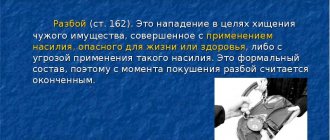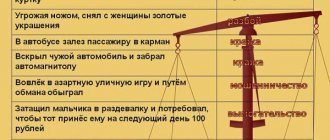Robbery - corpus delicti
This type of crime is characterized by the following features:
- the object is the property and health (life) of a person;
- The objective side is characterized by active actions in the form of an attack, the use of violence or threats. Such actions may include not only actions committed by the guilty person, but also the use of dogs for attack, as well as injections, the administration of which poses a health hazard;
- the subject is a legally capable person who is 14 years old;
- The subjective side is characterized by direct intent with a selfish goal. The emergence of intent to seize someone else's property must occur before the moment of the attack.
When a robbery is committed by a group of persons by prior conspiracy, the punishment is determined in accordance with Part 2 of Art. 162 of the Criminal Code of the Russian Federation. The law provides for imprisonment for up to 10 years and fines. A similar punishment is imposed for robbery with a weapon.
Such crimes pose a danger to society, so strict penalties have been established to prevent them. When committing this act, the use of weapons can be expressed in any actions with them, demonstrations or threats of their use.
What elements of robbery are classified as especially qualified crimes?
Robbery with specially qualified personnel includes the following categories of crimes:
- committed by a person belonging to an organized group;
- committed on a large or especially large scale;
- causing serious harm to health.
The presence of one of the above elements as part of a crime entails the application of the most severe punishment.
Note! If there is a fact of complicity, the judicial authority applies severe penalties to the perpetrator(s) to prevent such offenses.
Commentary to Art. 161 of the Criminal Code of the Russian Federation
Robbery is a form of theft. Objective and subjective signs of theft are disclosed in the commentary to Art. 158 of the Criminal Code of the Russian Federation. Robbery, like theft, belongs to the simplest type of crime against property - kidnapping (theft). The subject of robbery can only be physical movable things (for example, the unauthorized seizure of someone else's apartment or land cannot be qualified as robbery). Robbery requires both the conversion of someone else's property in favor of the culprit or another person, and its removal from someone else's possession (illegal retention of someone else's property, not associated with its unlawful removal from someone else's possession, does not constitute robbery).
A characteristic feature that distinguishes robbery from theft is the method - theft during robbery must be open. Due to the particular audacity of the criminal, robbery is considered a more dangerous crime than theft. It is believed that even if a robber does not use violence, then, in view of the daring method of theft he has chosen, he is internally ready to use violence and allows its use when difficulties arise, if this is necessary for the implementation of criminal intent.
The expanded concept of open theft is given in paragraph 3 of the Resolution of the Plenum of the Supreme Court of the Russian Federation of December 27, 2002 No. 29 “On judicial practice in cases of theft, robbery and robbery”: “Open theft of someone else’s property, provided for in Article 161 of the Criminal Code of the Russian Federation (robbery) , is such a theft that is committed in the presence of the owner or other holder of property or in full view of strangers, when the person committing this crime is aware that the persons present understand the illegal nature of his actions, regardless of whether they took measures to suppress these actions or not". The question of the difference between secret theft and open theft is discussed in detail in the commentary to Art. 158 of the Criminal Code of the Russian Federation.
Robbery differs from robbery by the nature of the violence that the offender uses or threatens to use. Violence during robbery, if it occurs, is not dangerous to life or health.
The interpretation of qualifying and especially qualifying signs of robbery is identical to the understanding of the same signs of theft. The only specific sign of robbery is the use of violence that is not dangerous to life or health, or the threat of its use. Violence should be understood as the use of physical force against a person. During robbery, it can be expressed in holding a person’s hands, knocking him down, tying him up, locking him in premises, using handcuffs, beatings or committing other violent acts related to causing physical pain to the victim or restricting his freedom.
Violence during robbery must not be dangerous to human life or health, i.e.:
a) should not cause any harm to human health, including lungs (it should be borne in mind that bodily injuries that do not result in health problems and loss of ability to work, for example bruises, abrasions, are not considered as harm to health; they can also occur during robbery );
b) should not be dangerous to life or health at the time of its use.
If, during the theft of someone else’s property, a violent restriction of freedom is applied to the victim, the issue of recognizing the person’s actions as robbery or robbery must be decided taking into account the nature and degree of danger of these actions to life or health, as well as the consequences that have occurred or could occur (for example, leaving a tied victim in a cold room, depriving him of the opportunity to seek help).
According to established judicial practice, the so-called jerk - snatching a bag or other objects from the hands of the victim - is not considered the use of violence in the process of committing a robbery. However, this rule should not be raised to a principle, since jerking in a particular situation can be outright violence, and sometimes violence that is dangerous to human life or health (for example, when using the energy of a moving car).
The use of violence against an animal, such as a dog, does not provide grounds for qualifying robbery as committed with the use of violence.
Considering that theft requires guilt in the form of direct intent, causing harm to health through negligence does not exclude the qualification of the act under the rule of robbery (and not under the rule of robbery).
During violent robbery, it is possible to use weapons that are not dangerous to life and health (for example, gas aerosol sprayers certified in Russia that are not dangerous to human health, which are classified by law as civilian self-defense weapons).
When qualifying robberies and assaults committed with the threat of violence, it is sometimes difficult to understand the nature of the violence threatened by the attacker. Verbal threats like “I’ll kill you!”, “I’ll cripple you!” cannot always be considered as threats of violence dangerous to life or health, most often these are simply threats of violence (unspecified) and there is no reason to fear that the threat will be carried out in its literal sense (although one cannot in principle exclude the understanding of verbal threats as threats of violence , dangerous to life and health). Another thing is that a threat with a knife, even if it is a small pocket knife, is almost always sufficient to qualify the attack as robbery. In cases where the seizure of property is associated with a threat of violence that is of an uncertain nature, the question of recognizing the person’s actions as robbery or robbery must be decided taking into account all the circumstances of the case: the place and time of the crime, the number of attackers, the nature of the objects with which they threatened the victim , subjective perception of a threat, the commission of any specific demonstrative actions indicating the attackers’ intention to use physical violence, etc.
What is the article for robbery?
In Art. 162 of the Criminal Code of the Russian Federation establishes the following types of offenses of robbery:
- with the absence of qualifying characteristics (simple). In this case, the following types of punishment may be applied:
- involvement in forced labor for a period of up to 5 years;
- imprisonment for up to eight years (with or without penalties of up to 500 thousand rubles);
General characteristics of robbery, robbery, theft
Robbery, robbery, theft are crimes against property. In all three cases, criminals unlawfully and without compensation confiscate (or) convert someone else’s property for their own benefit or for the benefit of other persons, which is called theft. In this case, criminals always act with direct intent and selfish motives (the only difference is the purpose of self-interest). The owners or legal owners of property stolen during robbery, theft, robbery suffer damage equal to at least the value of the stolen item.
Main types of robbery
When classifying robbery, the degree of severity, the number and age of persons participating in the commission of the illegal act, and the presence of weapons are taken into account.
When considering a case by investigative authorities and then by courts, the above factors are taken into account, as well as the conditions and features of the case. The most common types of robbery are:
- Property.
This type is characterized by a lesser degree of rigidity towards the victim. When committing property robbery, physical violence is not intended, since such a crime is committed for the purpose of enrichment.
- Armed.
Robbery is classified as armed robbery even without the use of weapons during the attack. Based on judicial practice, if there are weapons, it is assumed that criminals could use them. A weapon is also considered any object (stones, bottles, pipes, bats), the use of which can cause injury to the victim.
- Entering into private territory.
It could be an apartment, house, office, store, warehouse. This fact is considered an aggravating circumstance, which is taken into account when determining the punishment. If such a crime is committed, a more severe sanction is envisaged.
Note! Robbery attacks in which murders are committed are distinguished by the greatest degree of severity and the application of the maximum punishment to the offender in conjunction with Art. 105 of the Criminal Code of the Russian Federation.
Depending on the conditions under which the attack was committed, crimes are of the following types:
- Robbery on the roads.
Such crimes are committed with the aim of seizing funds belonging to the driver or a vehicle.
- An attack by an organized criminal group by prior conspiracy.
When committing such crimes, weapons may be used, and the victim is also often killed.
- Robbery on maritime transport.
If such a crime is committed, theft on a large scale is possible, as well as disruption of the operation of shipping routes. The damage caused is taken into account when the court makes a verdict.
Punishment and result of the crime
In Art. 162 of the Criminal Code of the Russian Federation provides for harsh measures in the form of imprisonment for a term of up to eight years in the event of committing even a simple offense.
Depending on the severity and specificity of the crime, the following penalties may be applied:
- forced labor for up to five years, as well as imprisonment for up to eight years and a fine of 500 thousand rubles. (or the amount of earnings over the last three years) if violence was committed or the offender threatened violence;
- imprisonment for up to ten years and a fine of up to 1 million rubles when committing a crime as part of an organized group or using weapons;
- imprisonment for a term of 7 to 12 years and a fine of up to 1 million rubles. for illegal entry;
- imprisonment for a term of 8 to 15 years and a fine, the amount of which can be up to 1 million rubles, for causing grievous harm to health, especially large damage.
What are the similarities
The general features of the crimes under consideration include the following:
- The object of encroachment is considered to be social relations that protect the property rights of a certain person.
- The subject of the crime is someone else's property.
- The subject may be a person over 14 years of age.
- The criminal commits his actions for personal gain. This means that he wants to improve his or someone else’s financial situation at the expense of stolen valuables.
- Crimes are considered completed at the moment when the criminal has the opportunity to dispose of the stolen valuables.
All crimes under consideration relate to cases of public prosecution. Therefore, the procedure for initiating criminal cases in these cases is the same. The reason for this is the following:
- statement of the injured party;
- statement about a crime that is being prepared;
- confession of the person who took part in the theft;
- prosecutor's decision to forward information for preliminary investigation.











